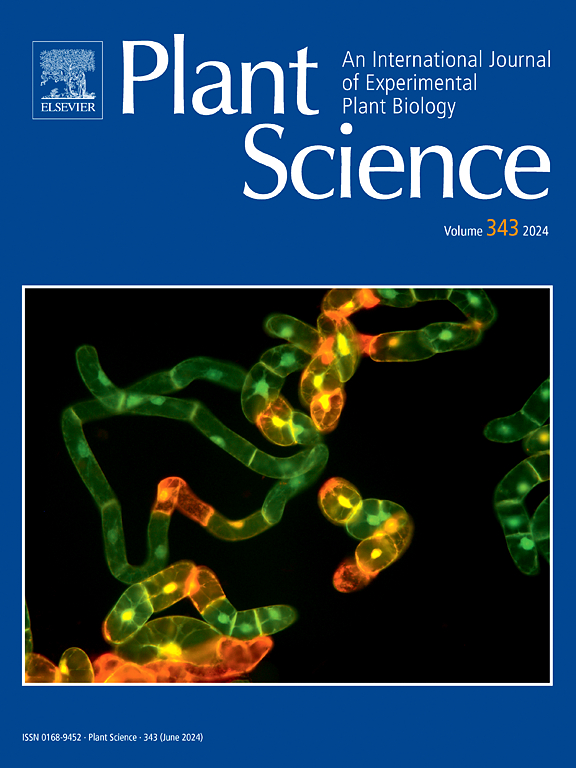赤霉病诱导的斜棘胆氧化应激和抗氧化防御的功能分区化。
IF 4.2
2区 生物学
Q2 BIOCHEMISTRY & MOLECULAR BIOLOGY
引用次数: 0
摘要
Espinosa nothofagi(膜翅目)对Nothofagus obliqua (nothofaga科)芽诱导的瘿呈组织区隔化,其中内室(IC)专门用于幼虫的营养,外室(OC)与防御和保护有关。虽然以前的研究已经将活性氧(ROS)与胆囊的功能特化联系起来,但对不同胆囊腔室的氧化应激和抗氧化系统的综合分析仍然有限。此外,斜叶松是一种落叶植物,春季次生生长活跃,与瘿发育一致,可能影响宿主氧化还原动力学。本研究评估了活性氧的产生、脂质过氧化(MDA)、酶和非酶抗氧化系统在胆室和非管状茎(NGS)中的活性。我们假设胆中的ROS和抗氧化系统根据其功能被划分,NGS的二次生长导致ROS积累,这被抗氧化防御所抵消。组织化学和定量分析显示,IC中的氧化应激较低,这与脱氢抗坏血酸还原酶活性升高有关。OC表现出较高的H₂O₂水平、超氧化物歧化酶和谷胱甘肽还原酶活性,表明暴露于环境应激源。NGS导致最高的ROS水平,这与强烈的形成层活性以及强烈的酶促抗氧化反应有关。h2o2和类黄酮的共定位表明,这些化合物在胆囊和NGS中都是有效的活性氧清除剂。虽然每个器官都依赖于不同的策略,但都通过有效的酶和基于类黄酮的抗氧化机制有效地防止膜损伤。这些发现证明了氧化应激和防御的功能分区化,突出了氧化还原平衡在次生生长和胆囊发育中的作用。本文章由计算机程序翻译,如有差异,请以英文原文为准。
Functional compartmentalization of oxidative stress and antioxidant defense in Nothofagus obliqua galls induced by Espinosa nothofagi
Galls induced by Espinosa nothofagi (Hymenoptera) on Nothofagus obliqua (Nothofagaceae) buds exhibit tissue compartmentalization, with an inner compartment (IC) specialized for larval nutrition and an outer compartment (OC) associated with defense and protection. Although previous studies have linked reactive oxygen species (ROS) to functional specialization in galls, comprehensive analyses of oxidative stress and antioxidant systems in distinct gall compartments are still limited. Additionally, N. obliqua is a deciduous species with active secondary growth in spring, which coincides with gall development and potentially influences host redox dynamics. This study evaluated ROS production, lipid peroxidation (MDA), and the activity of enzymatic and nonenzymatic antioxidant systems in gall compartments and nongalled stems (NGS). We hypothesized that ROS and antioxidant systems in galls are compartmentalized according to their function and that secondary growth in NGS leads to ROS accumulation, which is counteracted by antioxidant defenses. Both histochemical and quantitative analyses revealed low oxidative stress in the IC, which was supported by elevated dehydroascorbate reductase activity. The OC presented increased H₂O₂ levels and superoxide dismutase and glutathione reductase activities, indicating exposure to environmental stressors. NGS resulted in the highest ROS levels, which were associated with intense cambial activity, along with strong enzymatic antioxidant responses. The colocalization of H₂O₂ and flavonoids suggests that these compounds act as effective ROS scavengers in both galls and NGS. Although each organ relies on distinct strategies, all effectively prevent membrane damage through efficient enzymatic and flavonoid-based antioxidant mechanisms. These findings demonstrate the functional compartmentalization of oxidative stress and defense, highlighting the role of redox balance during secondary growth and gall development.
求助全文
通过发布文献求助,成功后即可免费获取论文全文。
去求助
来源期刊

Plant Science
生物-生化与分子生物学
CiteScore
9.10
自引率
1.90%
发文量
322
审稿时长
33 days
期刊介绍:
Plant Science will publish in the minimum of time, research manuscripts as well as commissioned reviews and commentaries recommended by its referees in all areas of experimental plant biology with emphasis in the broad areas of genomics, proteomics, biochemistry (including enzymology), physiology, cell biology, development, genetics, functional plant breeding, systems biology and the interaction of plants with the environment.
Manuscripts for full consideration should be written concisely and essentially as a final report. The main criterion for publication is that the manuscript must contain original and significant insights that lead to a better understanding of fundamental plant biology. Papers centering on plant cell culture should be of interest to a wide audience and methods employed result in a substantial improvement over existing established techniques and approaches. Methods papers are welcome only when the technique(s) described is novel or provides a major advancement of established protocols.
 求助内容:
求助内容: 应助结果提醒方式:
应助结果提醒方式:


